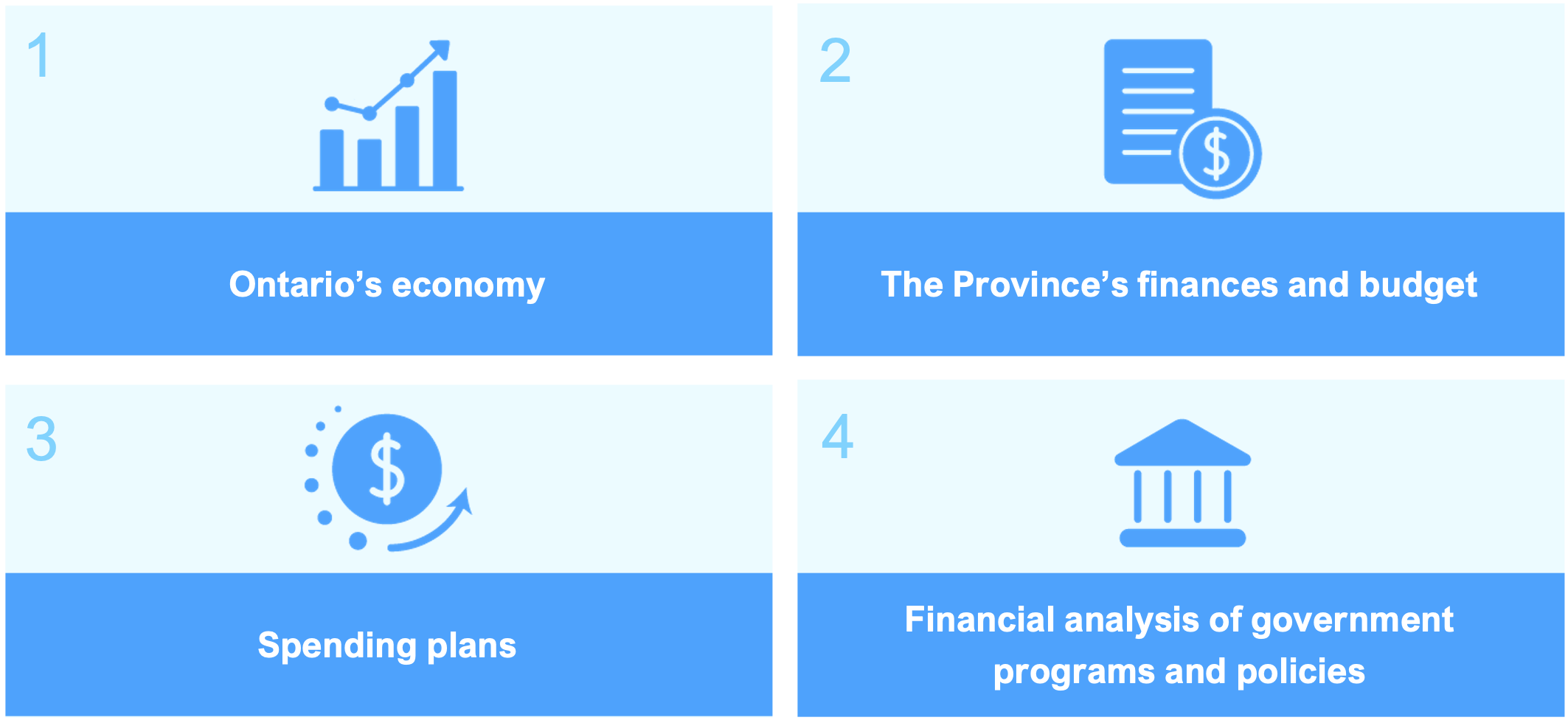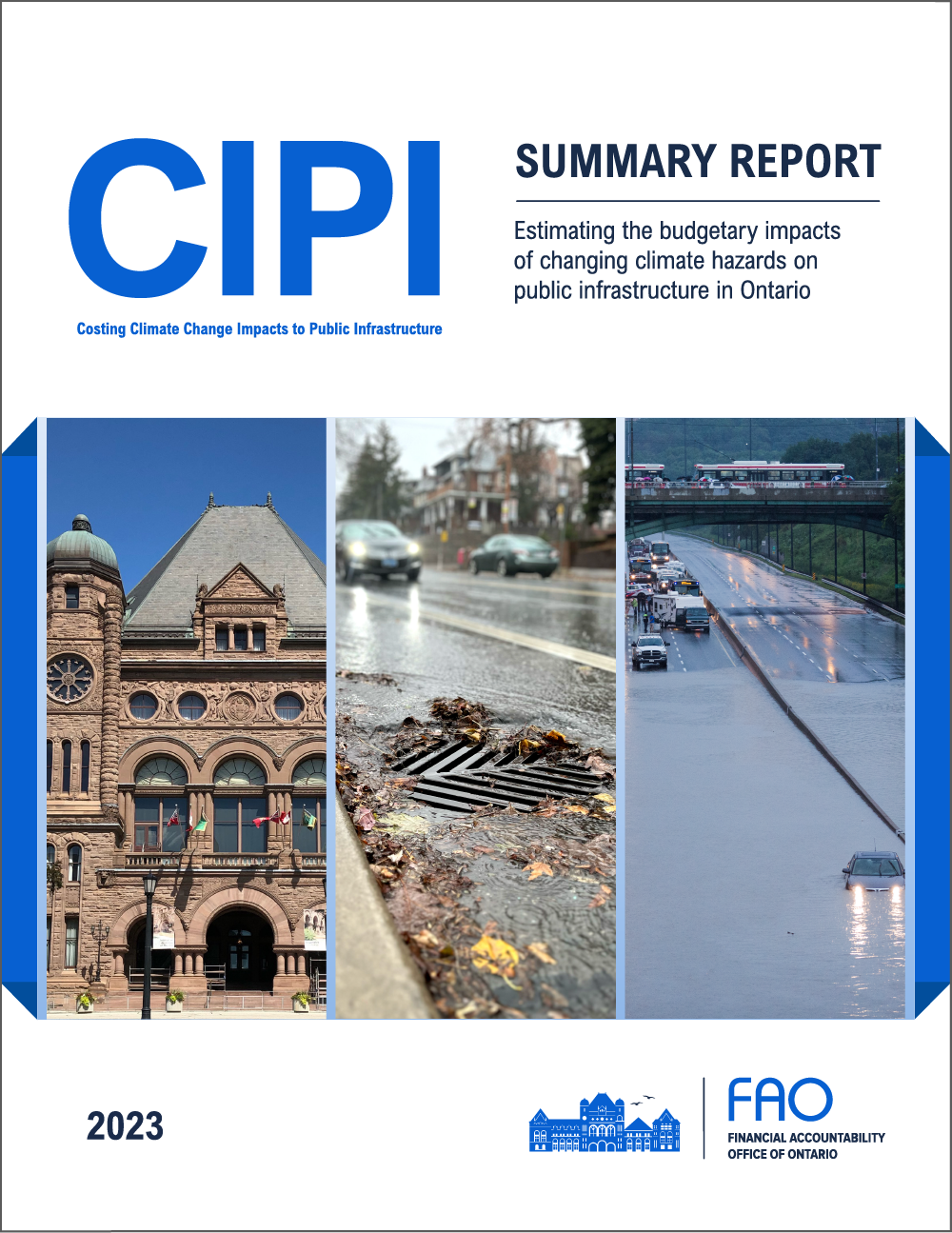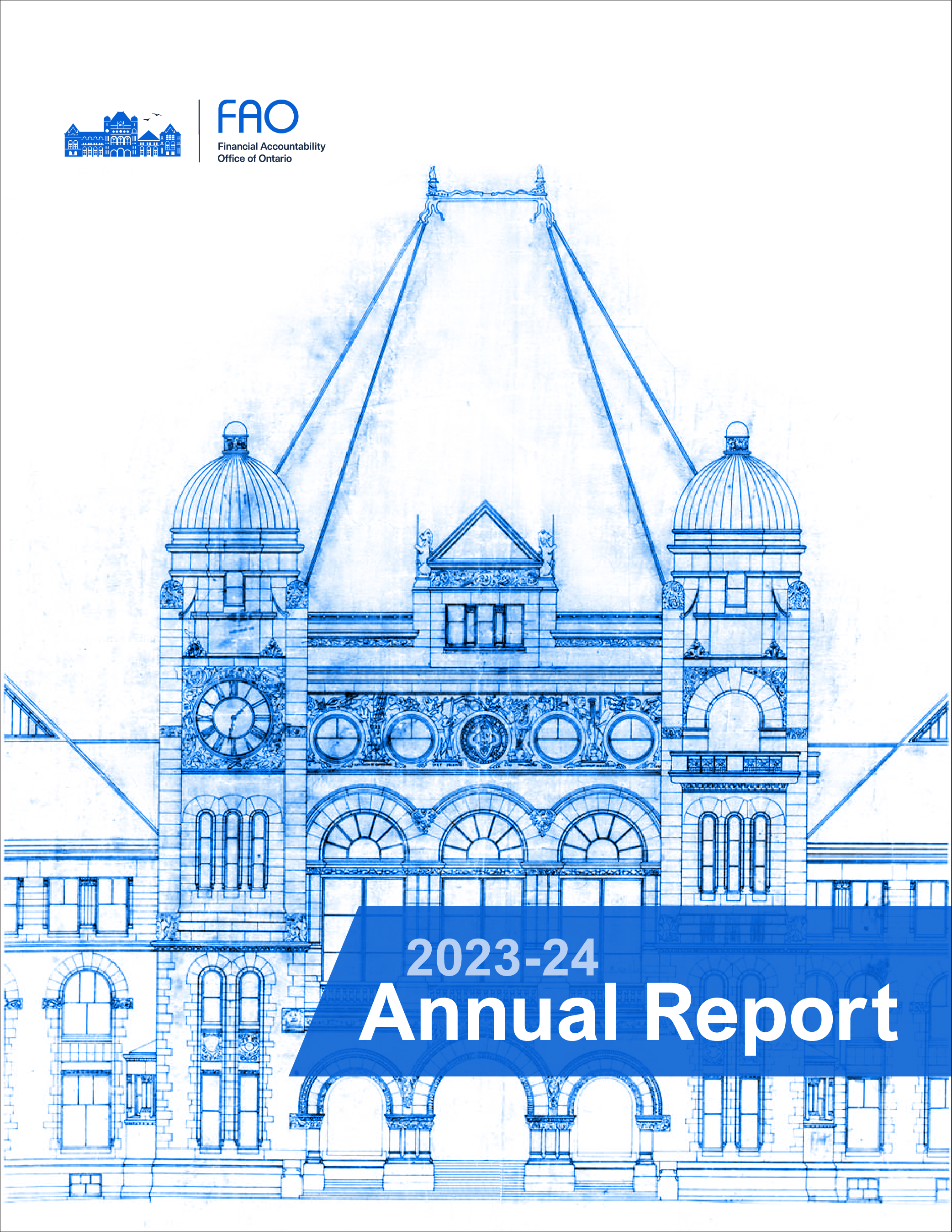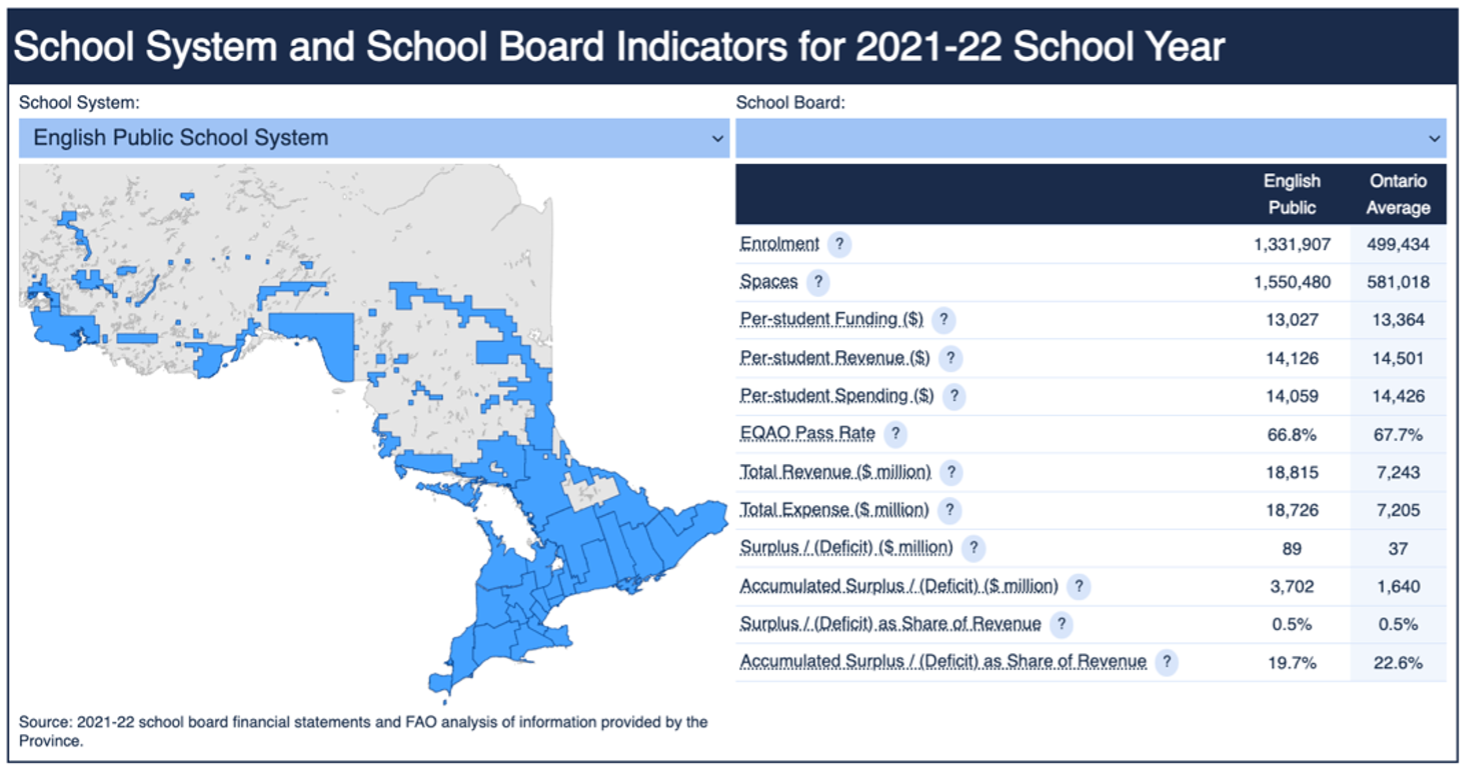July 31, 2024
The Honourable Ted Arnott
Speaker of the Legislative Assembly of Ontario
Main Legislative Building, Room 180
Queen’s Park
Toronto, Ontario
M7A 1A2
Dear Mr. Speaker:
In accordance with section 14 of the Financial Accountability Officer Act, 2013, I am pleased to present the 2023–24 Annual Report of the Financial Accountability Officer for your submission to the Legislative Assembly at the earliest reasonable opportunity.
Sincerely,

Jeffrey Novak
Financial Accountability Officer
Officer's Note
After serving as Acting Financial Accountability Officer, on November 3, 2023, I was honoured to be appointed by Order of the Legislative Assembly as Ontario’s third Financial Accountability Officer.
During my five-year term, my goal is to maintain the high-quality work produced by the dedicated staff of the Financial Accountability Office of Ontario (FAO), while continuing to strengthen the FAO’s support for the members and committees of the Legislative Assembly of Ontario.
The Financial Accountability Officer is mandated to provide independent financial and economic analysis to Members of Provincial Parliament (MPPs) and committees of the Assembly. The FAO is also available to undertake research at the request of an MPP or committee.
In 2023-24, the FAO produced 14 reports, 13 briefing decks, 12 videos and one interactive map. Our two most popular reports, as measured by views on our website, were Ontario Health Sector: 2023 Budget Spending Plan Review and Ontario School Boards: Enrolment, Finances and Student Outcomes. Both of these reports were undertaken as a result of research requests from MPPs.
The FAO also released the Costing Climate Change Impacts to Public Infrastructure (CIPI): Summary Report. Another research request from an MPP, the CIPI project was launched in 2019 and began with two reports that assessed the composition and state of repair of provincial and municipal infrastructure. The CIPI Summary Report completed the CIPI project by estimating the costs that climate change impacts could impose on Ontario’s provincial and municipal infrastructure, and how those costs could impact the long-term budget outlook of the Province.
Looking forward, the FAO will continue to focus on its mission to provide MPPs and committees with independent, authoritative, accessible and timely financial and economic analysis. To that end, this year we plan to conduct a survey of MPPs and begin an annual retrospective report on the FAO’s forecasting accuracy. In addition, to better serve MPPs, we have already launched a new quarterly report on the latest trends in the Ontario economy; a new interactive website tool that allows users to review in detail the Expenditure Estimates for several key ministries and compare requested spending against spending over prior years; and a revised quarterly newsletter that collects the FAO’s most recent work and lists our work in progress.
The rest of this report provides an overview of the FAO’s mission and mandate, key operating considerations, and a summary of the FAO’s work in the 2023-24 fiscal year.

Jeffrey Novak
Financial Accountability Officer

The FAO's Mission and Mandate
Mission
To support the Legislative Assembly by providing members and committees with independent, authoritative, accessible and timely financial and economic analysis.
Mandate
The Financial Accountability Officer Act, 2013 sets out the mandate of the Financial Accountability Officer (the Officer). The Officer is required to provide independent analysis to the Assembly about the state of the Province’s finances, including the budget, and trends in the provincial and national economies.
In addition, the Officer may respond to requests from members and committees of the Assembly to undertake research into:
- the Province’s finances and trends in the provincial and national economies;
- the estimates and supplementary estimates submitted to the Legislature;
- the financial costs or financial benefits to the Province of any public bill that is before the Assembly; or
- to estimate the financial costs or financial benefits to the Province of any proposal that relates to a matter over which the Legislature has jurisdiction, including any proposal made by the Government or by any member of the Assembly.
Finally, at the request of the Standing Committee on Finance and Economic Affairs (the Committee), the Officer and his staff are required to attend meetings of the Committee and to provide assistance. The Officer may also assist other standing or select committees upon request.
FAO Work in 2023-24
Activities in 2023-24
The FAO delivers its analysis to Members of Provincial Parliament (MPPs) and committees in the form of public reports, briefing decks, videos, interactive graphics and tools, and learning modules, all of which are posted to the FAO’s website and social media channels to increase accessibility and awareness.
In 2023-24, the FAO produced 14 reports, 13 briefing decks, 12 videos and one interactive map.
In general, the FAO’s work covers four areas:

Ontario’s Economy
The FAO provides semi-annual forecasts of Ontario’s economy through its Economic and Budget Outlook (EBO) reports. The Economic and Budget Outlook, Spring 2023 noted that after two years of very strong economic growth Ontario's economy was expected to slow sharply in 2023, reflecting the impact of elevated inflation, high interest rates and a weaker global environment. The Economic and Budget Outlook, Winter 2024 forecasted that the economy would slow further in 2024, as higher interest rates continue to impact household spending, the housing market and business investment.
The FAO also released several reports in 2023-24 examining important economic trends in Ontario.
The Women in Ontario’s Labour Market report analyzed labour market trends of women in Ontario. Rising educational attainment, increased opportunities in the service sector, flexible work arrangements and family-friendly government policies have helped lift the labour participation rate of Ontario women. Despite advancements, however, women continue to face labour market disparities compared to men, including barriers to opportunities and earnings. The report also looked at the Canada-Ontario Early Years and Child Care Agreement between Ontario and the federal government. Assuming the objectives in the agreement are met, the FAO estimates that the program has the potential to boost the labour force participation rate of mothers with young children.
The Labour Market Outcomes of Immigrants in Ontario and its Major Cities report highlighted long-term trends of international immigrants in Ontario's labour market. International immigration has become a significant source of Ontario’s labour force growth, contributing to nearly two-thirds of the increase in the province’s workforce since the mid 2010s. Recent immigrants have been faring better in the labour market, reflecting their higher education and pre-admission Canadian work experience.
The Ontario’s Labour Market in 2023 report highlighted that Ontario’s labour market moderated in 2023 with employment increasing by 183,200 jobs following two years of record job gains. Following two years of wage growth lagging inflation, the average hourly wage of Ontario workers increased by 5.1 per cent in 2023, above the 3.8 per cent rate of inflation.
The Province’s Finances and Budget
In addition to forecasts for the provincial economy, Economic and Budget Outlook (EBO) reports provide projections for the Province’s finances and compare the FAO’s provincial budget outlook to the government’s plans presented in Ontario Budgets and Fall Economic Statements. In the Economic and Budget Outlook, Spring 2023 report, the FAO projected a $0.5 billion budgetary surplus in 2022-23, with growing surpluses over the outlook as strong revenue growth was projected to outpace growth in spending under current government policies and announced commitments. However, the Economic and Budget Outlook, Winter 2024 report projected a significant deterioration in the budget outlook compared to the FAO’s Spring projection, with deficits from 2023-24 to 2025-26 and a balanced budget in 2026-27. The deterioration was largely due to lower-than-expected personal income tax revenues and higher projected spending for public sector salaries and wages, new government policy measures and debt interest payments.
The FAO also provides an annual assessment of the Province’s credit rating. The Province’s debt is rated by four principal international credit rating agencies, based on their assessments of Ontario’s economic and financial outlook, and future risks. These credit ratings represent the agencies’ opinions on the Province’s ability to meet its debt-related financial obligations. The FAO’s Ontario's Credit Rating: Fall 2023 Update noted that the credit rating agencies rate the Province as an extremely strong, investment-grade borrower, based on Ontario’s large and diversified economy, high liquidity and prudent debt management program. In 2023, three of the four credit rating agencies revised the Province’s credit rating outlook from stable to positive, indicating a potential rating upgrade. The revision reflected the agencies’ view that Ontario’s fiscal outlook had improved, with a quicker return to balanced budgets and a lower debt burden than previously forecasted.
Spending Plans
To support MPPs’ and committees’ understanding of government spending, the FAO conducts reviews of ministry spending plans. These reports include a financial overview of the selected ministry and an analysis of key financial issues. In 2023-24, the FAO reviewed the spending plans for two ministries, Health and Long-Term Care, in Ontario Health Sector: 2023 Budget Spending Plan Review. This report noted that the Province added $15.2 billion in new health sector funding in the 2023 Ontario Budget, which the FAO estimated was $4.4 billion more than what was necessary to fund existing programs and announced commitments from 2022-23 to 2025-26. The report also reviewed federal government support for provincial health sector spending. The FAO estimated that the federal government supported about 24.5 per cent of the Province’s health sector spending in 2022-23 and, based on new agreements with the federal government, was expected to reach 26.1 per cent in 2027-28.
On a quarterly basis, the FAO provides information on actual unaudited government spending. These Expenditure Monitor reports also identify changes made by the Province to its spending plan, compare actual unaudited spending against the government’s spending plan and spending in the previous year, and report on the status of the Contingency Fund.
Financial Analysis of Government Programs and Policies
 At the request of MPPs or committees, or on the initiative of the Officer, the FAO provides financial analysis of government programs and policies.
At the request of MPPs or committees, or on the initiative of the Officer, the FAO provides financial analysis of government programs and policies.
CIPI: Summary Report - Estimating the budgetary impacts of changing climate hazards on public infrastructure in Ontario, the final report in the Costing Climate Change Impacts to Public Infrastructure (CIPI) project, examined the impact that climate change will have on the cost of maintaining the $708 billion portfolio of public infrastructure owned by the Province and Ontario’s 444 municipalities.
Infrastructure is designed, built and maintained to withstand a specific range of climate conditions, typically based on historical climatic data. However, climate change is causing more frequent and intense extreme rainfall and extreme heat, and fewer freeze-thaw cycles in Ontario. These changing climate hazards are raising the costs to maintain infrastructure in a state of good repair through increased operations and maintenance activities, more frequent rehabilitations and earlier renewals.
The FAO examined these climate-related costs in three sectoral reports, covering public buildings, transportation infrastructure and linear storm and waste water infrastructure. The CIPI Summary Report was the culmination of the three sector reports and found that in the absence of adaptation, these changing climate hazards will add $4.1 billion per year on average to the costs of maintaining the existing portfolio of public infrastructure over the rest of the century. If assets are adapted, these costs would average $3.0 billion per year.
For the Province, which owns 29 per cent of these assets, climate-related infrastructure costs on provincial assets are unlikely to significantly impact the Province’s long-term finances, adding between 2.8 to 3.4 percentage points to the Province’s net debt-to-GDP ratio by the end of the century. Ontario’s municipalities, which own 71 per cent of these assets, will incur the majority of climate-related infrastructure costs, similar to the amount they currently spend on social housing or health and emergency services each year.
Ontario School Boards: Enrolment, Finances and Student Outcomes examined how provincial funding is allocated to Ontario’s 72 district school boards and reviewed differences across English Public, English Catholic, French Public and French Catholic school systems. The report also analyzed the demographic composition of Ontario’s students and the availability of French-system and Catholic-system school spaces; analyzed school board spending, budget balance and accumulated surplus patterns; and discussed academic performance by school board and system.
This report was accompanied by an interactive map that allows users to compare data from individual school boards and school systems to the provincial average, determine how a given school board ranks among Ontario’s 72 district school boards, and evaluate different characteristics by individual school board, such as enrolment, spaces, per-student funding, revenue and expenses, remoteness, and other attributes.
How the FAO Supports MPPs and Committees
The FAO provides independent financial and economic analysis to the members and committees of the Legislative Assembly of Ontario.
As noted in the previous chapter, the FAO primarily supports MPPs and committees through reports, briefing decks, videos, interactive graphics and tools, and learning modules. In addition, the FAO accepts research requests from MPPs and committees, offers briefings, produces a quarterly newsletter, and posts all of our work on the FAO’s website and social media channels.
One measure of the effectiveness of the FAO’s support for MPPs and committees is through the use of our work in the House and by committees. In 2023-24, the FAO was mentioned 123 times in the House and 65 times by a committee. In total, the FAO was mentioned on 84 per cent of the Legislative Assembly’s sitting days in 2023-24, up from 74 per cent in 2022-23.
Accessible version
In 2023-24, the FAO was mentioned 188 times in Legislature.
This line chart illustrates the percentage of times the FAO was mentioned in legislature. In 2018-19, the FAO was mentioned 55% of sitting days in legislature; in 2019-20, the FAO was mentioned 76% of sitting days in legislature, in 2021-21 the FAO was mentioned 75% of sitting days in legislature; in 2021-22, the FAO was mentioned 73% of sitting days in legislature; in 2022-23, the FAO was mentioned 74% of sitting days in legislature; and in 2023-24, the FAO was mentioned 84% of sitting days in legislature.
Research Requests
As mandated by the Financial Accountability Officer Act, 2013, the FAO accepts research requests from MPPs and committees under the following categories:
- the Province’s finances and trends in the provincial and national economies;
- the estimates and supplementary estimates submitted to the Legislature;
- the financial costs or financial benefits to the Province of any public bill that is before the Assembly; or
- to estimate the financial costs or financial benefits to the Province of any proposal that relates to a matter over which the Legislature has jurisdiction, including any proposal made by the Government or by any member of the Assembly.
The Financial Accountability Officer has the discretion to accept or reject a research request. In general, the FAO considers whether the research request fits within the Officer’s legislated mandate, whether the research request is expected to be feasible, and resource requirements. In 2023-24, the FAO received six research requests from MPPs and accepted four.
Briefings
All work produced by the FAO is accompanied by briefings for interested committees, MPPs and staff. Each briefing includes an overview presentation and an opportunity for attendees to ask questions. To accommodate schedules, the FAO offers two briefings for interested MPPs and staff on the day a report is released. On request, the FAO will also schedule additional briefings for committees, MPPs or staff.
In 2023-24, the FAO held 13 briefings for MPPs and staff. There were 59 attendees, of which 19 were MPPs and 40 were staff.
Newsletters
The FAO releases a quarterly newsletter so that MPPs and subscribers can stay informed on FAO activities. This newsletter was refreshed in the fourth quarter of 2023-24. Based on feedback received from MPPs, each newsletter summarizes the FAO’s work in the quarter just completed and lists FAO work in progress that is expected to be released in the upcoming three months.
Website
All of the FAO’s work is publicly available on our website, which is the primary access point for MPPs to examine our work. In 2023-24, the FAO’s website was viewed 169,490 times, consistent with the annual number of views since 2019-20.
Accessible version
In 2023-24, the FAO’s website was viewed 169,490 times.
This line chart illustrates website views by year: in 2015-16 the website had 34,897 views, in 2016-17 the website had 91,473 views, in 2017-18 the website had 74, 857 views, in 2018-19 the website had 108,202 views, in 2019-20 the website had 179,760 views, in 2020-21 the website had 169,717 views, in 2021-22 the website had 197,278 views, in 2022-23 the website had 184,010 views, in 2023-24 the website had 169,490 views.
The FAO’s most popular report released in 2023-24 was Ontario Health Sector: 2023 Budget Spending Plan Review, with 7,774 views. Rounding out the top five most viewed reports released in 2023-24 were:
- Ontario School Boards: Enrolment, Finances and Student Outcomes;
- Labour Market Outcomes of Immigrants in Ontario and its Major Cities;
- Economic and Budget Outlook, Spring 2023; and
- Women in Ontario’s Labour Market.
Accessible version
This bar chart illustrates the top 5 report viewed on the FAO’s website. The FAO’s most popular report released in 2023-24 was Ontario Health Sector: 2023 Budget Spending Plan Review, with 7,774 views. Ontario School Boards: Enrolment, Finances and Student Outcomes with 3.835 views. Labour Market Outcomes of Immigrants in Ontario and its Major Cities with 3,512 views. Economic and Budget Outlook, Spring 2023 with 3,001 views and Women in Ontario’s Labour Market with 2,555 views.
Social Media
FAO social media platforms are a key resource for MPPs and the public to stay up to date with FAO activities and reports. The FAO’s work is shared across three social media platforms: X (formerly Twitter), LinkedIn and Instagram. FAO content posted on these platforms allows MPPs and their staff to access information from FAO work in a timely, simple and quick medium.
Additionally, MPPs, staff, media and members of the public are able to subscribe to FAO news alerts to receive email notifications on reports and newsletters.
The follower rate has steadily increased across all FAO social media platforms. When looking at year-over-year growth, in 2023-24, X followers increased by four per cent, LinkedIn followers increased by 37 per cent and Instagram followers increased by five per cent. As well, email subscribers increased by 14 per cent in 2023-24.
Access to and Disclosure of Information
Access to Information
Access to government information is a key requirement for the FAO to meet its legislated mandate. Under the Financial Accountability Officer Act, 2013, ministries and public entities have a statutory duty to provide the FAO with information that the Officer believes necessary to perform his duties, subject to only limited exceptions. In addition, three orders in council provide the FAO with access to certain information contained in Cabinet records from the current Executive Council, presided over by Premier Ford, and the previous two Executive Councils, presided over by Premier Ford and former Premier Wynne.
In 2023-24, the FAO maintained its professional working relationship with ministries and public entities. The FAO made 23 information requests to the government and was provided with timely access to all requested information as legally required.
Disclosure of Information
Although the FAO has access to a wide range of information, the Financial Accountability Officer Act, 2013 and the orders in council place important restrictions on the FAO’s ability to publicly disclose certain information that it receives from ministries and public entities.
Accordingly, the FAO has put in place internal processes that ensure information subject to these restrictions is not publicly disclosed. As part of these processes, ministries and public entities provide advice to the FAO, which helps to ensure that the FAO complies with its disclosure of information obligations.
Financial Statement
The Financial Accountability Office of Ontario’s fiscal year runs from April 1, 2023 to March 31, 2024.
Total spending (unaudited) by the FAO in 2023-24 was $3,994,411. This was $158,389 less than the FAO’s approved budget for 2023-24 and $45,292 more than total spending (audited) in 2022-23.
The accounts and financial statements of the FAO are audited annually by the Office of the Auditor General of Ontario. This financial statement was unaudited at the time of publication.
| 2023-24 Budget |
2023-24 Actual (Unaudited) |
2022-23 Actual |
|
| Salaries and wages | $2,660,300 | $2,632,168 | $2,644,777 |
| Employee benefits | $683,100 | $612,325 | $492,943 |
| Transportation and communication | $56,500 | $12,765 | $25,082 |
| Services | $642,900 | $702,381 | $734,417 |
| Supplies and equipment | $110,000 | $34,773 | $51,900 |
| Total | $4,152,800 | $3,994,411 | $3,949,119 |
Year In Review 2023-24
Accessible version
Year In Review
In 2023-24, the FAO produced 14 reports, 13 briefing decks, 12 videos and one interactive map.
The FAO’s website was also viewed 169,490 times.
Top 5 Report Views
The bar chart illustrates the top 5 report viewed on the FAO’s website. The FAO’s most popular report released in 2023-24 was Ontario Health Sector: 2023 Budget Spending Plan Review, with 7,774 views. Ontario School Boards: Enrolment, Finances and Student Outcomes with 3.835 views. Labour Market Outcomes of Immigrants in Ontario and its Major Cities with 3,512 views. Economic and Budget Outlook, Spring 2023 with 3,001 views and Women in Ontario’s Labour Market with 2,555 views.
Supporting MPPs
In 2023-24, the FAO was mentioned 188 times in Legislature.
The line chart illustrates the percentage of times the FAO was mentioned in legislature. In 2018-19, the FAO was mentioned 55% of sitting days in legislature; in 2019-20, the FAO was mentioned 76% of sitting days in legislature, in 2021-21 the FAO was mentioned 75% of sitting days in legislature; in 2021-22, the FAO was mentioned 73% of sitting days in legislature; in 2022-23, the FAO was mentioned 74% of sitting days in legislature; and in 2023-24, the FAO was mentioned 84% of sitting days in legislature.
The FAO received six MPP Research Requests in 2023-24.
The FAO provided 13 briefings for MPPs and staff. There were 59 attendees in total in 2023-24.
In 2023-24, X followers increased by four per cent, LinkedIn followers increased by 37 per cent and Instagram followers increased by five per cent. As well, email subscribers increased by 14 per cent in 2023-24.



